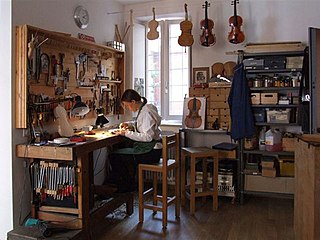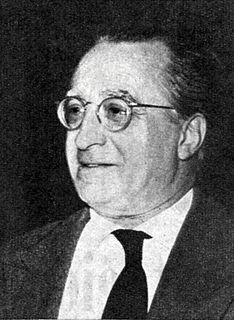Carlo Bergonzi may refer to:
- Carlo Bergonzi (luthier) (1683–1747), Italian luthier
- Carlo Bergonzi (tenor) (1924–2014), Italian operatic tenor
Carlo Bergonzi may refer to:

Renata Tebaldi was an Italian lirico-spinto soprano popular in the post-war period, and especially prominent as one of the stars of La Scala, San Carlo and, especially, the Metropolitan Opera. Often considered among the great opera singers of the 20th century, she focused primarily on the verismo roles of the lyric and dramatic repertoires. Italian conductor Arturo Toscanini called her voice "la voce d'angelo", and La Scala music director Riccardo Muti called her "one of the greatest performers with one of the most extraordinary voices in the field of opera."

Carlo Bergonzi was an Italian operatic tenor. Although he performed and recorded some bel canto and verismo roles, he was above all associated with the operas of Giuseppe Verdi, including many of the composer's lesser known works he helped revive. He sang more than forty other roles throughout his career.

A luthier is a craftsperson who builds or repairs string instruments that have a neck and a sound box. The word "luthier" is originally French and comes from the French word for lute. The term was originally used for makers of lutes, but it came to be used already in French for makers of most bowed and plucked stringed instruments such as members of the violin family and guitars. Luthiers, however, do not make harps or pianos; these require different skills and construction methods because their strings are secured to a frame.

Carlo Bergonzi was an Italian luthier and is the first and most noted member of the Bergonzi family, an illustrious group of luthiers from Cremona, Italy, a city with a rich tradition of stringed instrument makers. Today his instruments are highly valued for their workmanship and tone. Although he was historically assumed to have first apprenticed with Hieronymus Amati or Antonio Stradivari, he is now known to have been the student of Vincenzo Rugeri.
The Kreisler Bergonzi is an antique violin made by the Italian luthier Carlo Bergonzi (1683–1747) from Cremona in 1740.
Salvatore Licitra was an Italian operatic tenor.
Testore is an Italian surname.

The violin, viola, and cello were first made in the early 16th century, in Italy. The earliest evidence for their existence is in paintings by Gaudenzio Ferrari from the 1530s, though Ferrari's instruments had only three strings. The Academie musicale, a treatise written in 1556 by Philibert Jambe de Fer, gives a clear description of the violin family much as we know it today.

Matteo Goffriller (1659–1742) was a Venetian luthier, particularly noted for the quality of his cellos. He was active between 1685–1735 and was he founder of the "Venetian School" of luthiers, during a time when Venice was one of the most important centers of musical activity in the world.
Francesco Rugeri, also known as Ruger, Rugier, Rugeri, Ruggeri, Ruggieri, Ruggerius, was the first of an important family of luthiers, the Casa Rugeri in Cremona, Italy. His instruments are masterfully constructed. His violins are inspired by Nicolò Amati's "Grand Amati" pattern. Francesco was the first to develop a smaller cello design, which has become the standard for modern cello dimensions. Today, Rugeri's instruments are nearly as renowned as Nicolò Amati's instruments.

Franco Capuana was an Italian conductor.
Luigi Rinaldo Legnani was an Italian virtuoso guitarist, singer, composer and luthier.
Luca Pisaroni is an Italian operatic bass-baritone, known for his roles in Mozart's operas, but who has steadily expanded his repertoire into the Baroque as well as moving beyond into Rossini.
Bergonzi is an Italian surname. It is the surname of the following:
Giovanni Battista Ceruti (1756–1817) was an Italian violin maker, and is considered a direct link to the grand tradition of the Cremonese master violin makers of the 18th century. He known for his violins, cellos and double basses.

Nicola Amati, Nicolò Amati or Nicolao Amati was an Italian Master Luthier from Cremona, Italy. Amati is one of the most well known luthier from the Casa Amati. Nicola was the teacher of illustrious Cremonese School luthiers such as Andrea Guarneri and Giovanni Battista Rogeri. While no clear documentation exists for being apprentices in his shop, Amati may have also apprenticed Antonio Stradivari, Francesco Rugeri, and Jacob Stainer as their work is heavily influenced by Amati.
Poggi is an Italian surname, derived from the word poggio, meaning knoll.
Riccardo Bergonzi began his work as a violin maker at the early age of 12 when he made his first instrument at Sefano Conia’s workshop. Bergonzi graduated at the top of his class and also received the Gold Medal “G. Merola” from the violin making school in Cremona in 1979. Shortly after his graduation, he began teaching at his alma mater. During his 10 years as a teacher, he received several awards for his instruments and was also awarded a gold medal as the “youngest violin maker” at the Bagnacavallo exhibition. Bergonzi’s attention to the set up and sound of his instruments has made him a highly successful violin maker, known throughout the world. Not only is he accomplished in this field, he has also enjoyed painting, sculpting, and wood and bronze working. His hobbies have complemented his work as a violin maker, causing him to be even more attentive to artistic details on his instruments. Recently, Bergonzi has taken the time to find joy in his hobbies after many years of violin making. *

Vincenzo Rugeri, was an Italian luthier of string instruments such as violins, cellos, and, violas in Cremona, Italy. His instruments are noted for their craftsmanship and tone quality. Vincenzo came from a distinguished family of luthiers, the first of whom was his father, Francesco Rugeri. Despite the local tradition of artisan families laboring together through generations, Vincenzo left the family shop and set up a successful shop of his own in the center of Cremona. Vincenzo was the third son of luthier Francesco Rugeri. Vincenzo's work, like Francesco's, is influenced by Nicolò Amati's Grand Pattern model, however Vincenzo's work was distinguished from his father's by utilizing a lower arch inspired by Antonio Stradivari. An analysis of the body of his work reveals that the quality of Vincenzo's instruments is remarkable, perhaps even more so than his father's. Vincenzo's instruments, though less numerous, are valued at least equal to those of his father. A violin by Vincenzo Rugeri realized $502,320 on October 3, 2011 at Brompton's Auctions in London. Carlo Bergonzi was a distinguished apprentice of Vincenzo Rugeri.